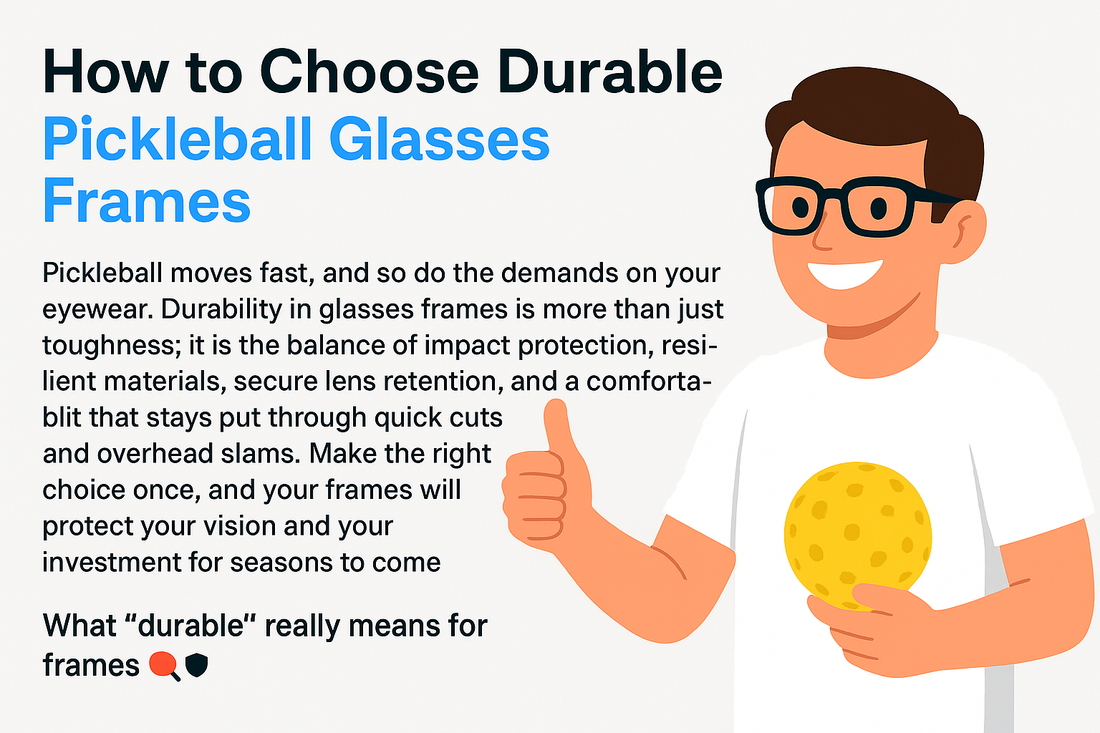
How to Choose Durable Pickleball Glasses Frames
Pickleball moves fast, and so do the demands on your eyewear. Durability in glasses frames is more than just toughness; it is the balance of impact protection, resilient materials, secure lens retention, and a comfortable fit that stays put through quick cuts and overhead slams. Make the right choice once, and your frames will protect your vision and your investment for seasons to come 🏓🛡️.
What “durable” really means for frames
- Impact resistance: Frames should flex instead of crack when the ball or paddle makes contact.
- Flex memory: Material should bend and return to shape without permanent warping.
- Fatigue resistance: Repeated on-off cycles and sweat exposure should not loosen the structure.
- Lens retention: The design must hold lenses securely during sudden movement and vibration.
- Surface durability: Finishes and coatings should resist sweat, sunscreen, and cleaning chemicals.
Best frame materials for pickleball
TR-90 / Grilamid nylon: The gold standard for sport frames. It is lightweight, highly flexible, and resists impact and temperature swings. Great for frequent play.
Polycarbonate frames: Not as common as polycarbonate lenses, but when used for frames they are tough and light. Look for reinforced bridges and temples to avoid flex fatigue.
Acetate: Stylish and stable, but heavier and more brittle if dropped on hard courts. Better for casual wear or lighter play.
Stainless steel: Slim and strong with good corrosion resistance. Choose thicker-gauge or hybrid designs with nylon temples for comfort and resilience.
Titanium: Excellent strength-to-weight ratio and good memory. Pair with robust hinges and grippy pads for sport stability.
Pro tip: Rubberized overmolds add grip but do not add structural strength; the core material still does the heavy lifting.
Hinges and hardware that last
Hinges are small parts that see big stress. Look for these features 🔧:
- Spring hinges: Offer flexibility for a snug fit and reduce the chance of bending out of shape.
- Screwless or captive-screw designs: Reduce the risk of screws backing out mid-match.
- Stainless hardware: Better against sweat corrosion than carbon steel.
- Replaceable contact points: Swap-out nose pads and temple tips extend the service life of the frame.
Quick check: open and close the temples. You should feel smooth resistance with a clean return, not grinding or wobble.
Frame design and coverage
Full-rim frames give the best lens security for pickleball. Semi-rimless designs reduce weight but can expose the lens edge to chips. Rimless frames are light and sleek, yet provide the least protection if the ball strikes the lens edge.
Wrap and curvature: Moderate wrap improves side coverage and stability. Look for integrated side shields or extended temples that block wind and glare without pinching.
Ventilation: Small vent channels at the brow or lens edge help control fog by moving warm air away from your face.
Strap compatibility: If you play intensely, choose frames with temple slots or end loops for a retainer strap.
Fit and comfort equals durability
Frames that fit well last longer because they are not fighting your face shape 👓.
- Bridge stability: A well-shaped or adjustable nose bridge spreads weight evenly so the frame does not bounce.
- Temple grip: Textured or rubberized tips keep glasses anchored without clamping too hard.
- Weight balance: Aim for light frames, ideally under 30 grams, with balanced front and temple weight to reduce slippage.
- Size matching: Choose the right width so temples sit straight, not flared, which stresses hinges.
In-store field test checklist
- Flex test: Gently twist the frame at the bridge. It should flex and rebound without creaking.
- Hinge test: Open to full extension; there should be no side-to-side play.
- Lens security: Press near the lens edges. There should be no clicking or movement inside the groove.
- Coverage and vision: Look side to side and up and down to confirm the frame does not intrude into your sightline.
- Fog control: Warm your breath across the lenses to see how quickly vents clear moisture.
- Helmet or hat check: If you wear a cap or visor, test for interference so temples do not flex outward.
Care tips to extend frame life
- Rinse sweat and dust with lukewarm water before wiping to prevent micro-scratches.
- Use a microfiber cloth and lens-safe cleaner; avoid paper towels and harsh solvents.
- Air-dry out of direct heat. Do not leave glasses on a car dashboard.
- Store in a hard case between games to protect hinges and lenses.
- Monthly check: tighten screws, replace worn nose pads, and inspect for stress whitening.
When to upgrade
It is time for new frames if you see white stress lines at the bridge, temples that no longer spring back, loose or chattering lenses, recurring fog that vents cannot clear, or yellowing materials that signal UV fatigue. Upgrading before a failure keeps your eyes protected and your game sharp 🔄.
Choose smart, test thoroughly, and maintain regularly. With the right materials, hardware, and fit, your pickleball glasses frames will be a reliable part of your kit match after match.



